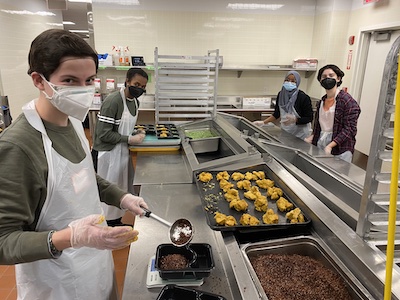 The COVID-19 pandemic has uncovered injustices that are more complex and connected than some may understand, Jubi Oladipo ’24 reflected after working with a Boston nonprofit that makes and delivers medically tailored meals to people with chronic and critical illnesses.
The COVID-19 pandemic has uncovered injustices that are more complex and connected than some may understand, Jubi Oladipo ’24 reflected after working with a Boston nonprofit that makes and delivers medically tailored meals to people with chronic and critical illnesses.
“Often, people with chronic illnesses and disabled people are left out of the narrative,” Oladipo said, noting that the pandemic added additional barriers for people in need to safely obtain healthy food. “Food insecurity is a really intersectional issue; so many different factors can impact a person’s ability to go grocery shopping and prepare meals that help them satisfy their medical needs.”
Oladipo and the other students in Andrea Geyling-Moore’s Activism for Justice in a Digital World course recently visited and worked in the kitchen of Community Servings, located in Boston’s Jamaica Plain neighborhood. Max Seelig ’22 said the visit opened his eyes to how food insecurity can have its origins in more than just poverty.
“Generally, the first image that comes to mind when we think of someone who’s food insecure is someone who is experiencing homelessness or poverty,” he said. “But access is not just financial. Physical health and location also determine access to food and meals.”
“Often, people with chronic illnesses and disabled people are left out of the narrative. Food insecurity is a really intersectional issue; so many different factors can impact a person’s ability to go grocery shopping and prepare meals that help them satisfy their medical needs.””
– Jubi Oladipo ’24
Such connections are core to the course, said Geyling-Moore. In the fall, students make a general declaration of human rights and learn examples of activism before getting into specific issues such as environmental justice, racism, poverty, food insecurity, and housing.
“By doing a hands-on project” like the visit to Community Servings, she said, “they have a chance to interact with people addressing these problems and an opportunity to see how these issues are connected.” Geyling-Moore then asked her students to perform some kind of action to address the issues they encountered during the visit. Student projects include additional research for an awareness-raising campaign and working on legislative efforts to help people in need.
All students in the course are required to make a weekly commitment to serve one of the school’s Community Engagement Programs and Partnerships sites, something that helps them to understand the connection between service and activism. “Through reading and hearing about different activists and the way they engage, a lot of the course comes down to raising awareness. So that’s often the stage where my students are, because before they can take action, they have to learn more about the issues.
“By engaging in site visits, they think, ‘What can I do now?’” Geyling-Moore said.